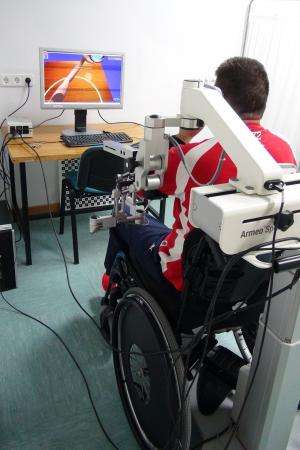Virtual reality and neurorobotics to speed up rehabilitation following strokes and spinal cord injuries

To speed up the recovery process of people who suffer motor disability. This is the ambitious aim of the HYPER research project which is using neurorobotics, neuroprosthetics and virtual reality to improve the life quality of patients whose mobility is limited.
It is the main research currently taking place in this field in Spain, it has a budget of 5 million euros, and the participation of the IK4 R&D Alliance under the coordination of the Spanish National Scientific Research Council (CSIC).
The project has been up and running since 2010 and has led to the development of a suite of innovative systems that facilitate new rehabilitation therapies and new systems to compensate gait in patients who have had spinal cord injuries or cerebral strokes. So far, various prototypes have been developed and one of them is undergoing a preliminary clinical validation process with 10 patients with spinal cord injuries at the National Hospital for Paraplegics in Toledo.
These encouraging results have led to the project being extended for a further year with funding from the Spanish Government's Consolider-Ingenio programme.
The prototype
Within the framework of the project IK4 has developed in collaboration with the HYPER partners a sophisticated rehabilitation prototype for patients with stroke or spinal cord injury; it is based on the use of an exoskeleton that monitors arm movements, makes a high-precision appraisal of the patient's posture in real time and uses virtual reality to recreate everyday life situations.
The main advantage of these tools lies in the fact that they will allow the rehabilitation processes to start earlier, are conducted more intensively and in a way that is more pleasant for the patient, and they contribute towards faster, more complete recovery.
The systems designed also facilitate a quantitative analysis of the progress the patients make, which will be very useful in the clinical evaluation by the professionals working in the rehabilitation process.
"It has been possible to meet this challenge through the work of a multidisciplinary team with technical as well as clinical researchers from national centres of excellence," said Eduardo Carrasco, head of the project at IK4.
One of the main challenges they will be facing in the future is "to validate the therapies developed in clinical trials with broad populations of patients and to make use of these solutions commercially," he added.
The role of IK4
In the initiative the VICOMTECH-IK4 centre has been responsible for exploring the potential of virtual reality in the project, while IK4-CIDETEC has undertaken to develop the sensors that are inserted into the prostheses and measure the pressure in order to respond naturally to the movement ordered by the patient.
According to the person responsible for the project, HYPER has contributed in a decisive way towards consolidating the line of research in neurorehabilitation at IK4 and has made it possible to build closer ties with top researchers and institutions.
In his view, the initiative "has catapulted the neurorehabilitation activity of the group and it is expected to have a significant impact on an industrial level in the Basque Country, since many companies are expressing interest in making use of the results obtained".
The project, which is being led by the Bioengineering Group of the Spanish National Scientific Research Council (CSIC), also has the collaboration of other players devoted to scientific and technological and medical research like the National Hospital for Paraplegics in Toledo, the universities of Zaragoza, Rey Juan Carlos and Carlos III, and the Institute of Bioengineering of Catalonia (IBEC), among others.



















